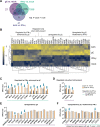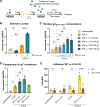This is a preprint.
Viral modulation of type II interferon increases T cell adhesion and virus spread
- PMID: 37292914
- PMCID: PMC10246016
- DOI: 10.1101/2023.05.26.542397
Viral modulation of type II interferon increases T cell adhesion and virus spread
Update in
-
Viral modulation of type II interferon increases T cell adhesion and virus spread.Nat Commun. 2024 Jun 22;15(1):5318. doi: 10.1038/s41467-024-49657-4. Nat Commun. 2024. PMID: 38909022 Free PMC article.
Abstract
During primary infection, varicella zoster virus (VZV) infects epithelial cells in the respiratory lymphoid organs and mucosa. Subsequent infection of lymphocytes, T cells in particular, causes primary viremia allowing systemic spread throughout the host, including the skin. This results in the expression of cytokines, including interferons (IFNs) which partly limit primary infection. VZV also spreads from skin keratinocytes to lymphocytes prior to secondary viremia. How VZV infects lymphocytes from epithelial cells while evading the cytokine response has not been fully established. Here, we show that VZV glycoprotein C (gC) binds IFN-γ and modifies its activity. Transcriptomic analysis revealed that gC in combination with IFN-γ increased the expression of a small subset of IFN-stimulated genes (ISGs), including intercellular adhesion molecule 1 (ICAM1), as well as several chemokines and immunomodulatory genes. The higher ICAM1 protein level at the plasma membrane of epithelial cells resulted in lymphocyte function-associated antigen 1 (LFA-1)-dependent T cell adhesion. This gC activity required a stable interaction with IFN-γ and signalling through the IFN-γ receptor. Finally, the presence of gC during infection increased VZV spread from epithelial cells to peripheral blood mononuclear cells. This constitutes the discovery of a novel strategy to modulate the activity of IFN-γ, inducing the expression of a subset of ISGs, leading to enhanced T cell adhesion and virus spread.
Keywords: ICAM1; Interferon gamma; LFA-1; T cell adhesion; biased signaling; immunomodulation; varicella zoster virus; virus spread.
Figures






References
Publication types
Grants and funding
LinkOut - more resources
Full Text Sources
Miscellaneous
